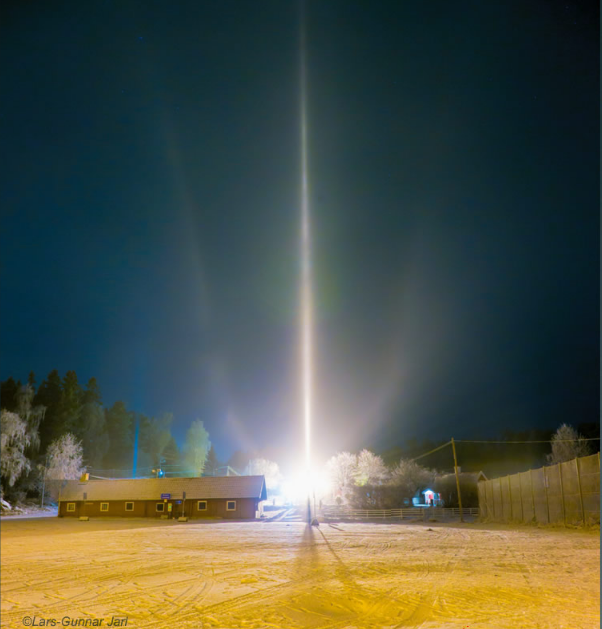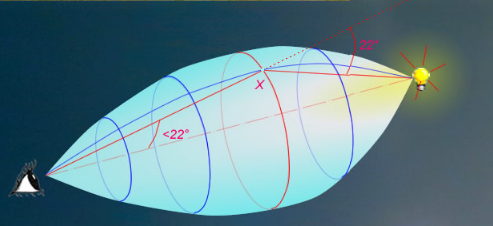Superparhelion, divergent light halo - OPOD
Superparhelion: Exploring the Mysteries of Divergent Light Halos
When it comes to atmospheric optics, there are numerous captivating phenomena that can leave us in awe of nature's beauty. One such phenomenon is the superparhelion, a type of divergent light halo that adds a touch of enchantment to our skies. In this article, we will delve into the intricacies of superparhelions and unravel the secrets behind their formation.
What is a Superparhelion?
A superparhelion is a unique ice halo generated by divergent light. Unlike ordinary halos, which result from parallel light, superparhelions are more exotic and rare. These extraordinary halos can be observed when the air is frigid and diamond dust ice crystals float through the atmosphere. The name "superparhelion" derives from its comparison to the more familiar subparhelion, another type of ice halo.
Unveiling the Divergent Light Halo
To understand the concept of divergent light halos, let's consider the "22° halo" as an example. Imagine standing near a point source lamp. A column ice crystal randomly oriented at a certain point deviates the lamp light through an angle of 22°. This deviation angle, known as the minimum deviation angle, causes the crystal to appear as a bright glint. Crystals positioned anywhere on the ring formed by this deviation will create a circular halo.
However, it's important to note that the radius of this halo is smaller compared to the 22° parallel light halo observed around the sun or moon. The proximity of the crystal to the lamp determines the size of the ring. Crystals located on the surface of an object, such as a pointed airship, will also glint light after a 22° deviation. This results in the formation of fainter halo extremities. As our eyes witness individual crystals glinting, the halo takes on a three-dimensional character, appearing closer to us than the lamp itself.
The Complexity of Superparhelion Halo Surface
The surface of a superparhelion halo is more intricate than that of a 22° halo. When a ray of light passes through a horizontal plate crystal, it enters and exits through prism side faces inclined at an angle of 60° to each other. The ray then undergoes internal reflection from the upper horizontal hexagonal face. This complex interaction between light and crystal structure gives rise to the mesmerizing patterns observed in superparhelions.
Exploring More Divergent Light Halos
While superparhelions are undoubtedly captivating, they are not the only type of divergent light halos that grace our skies. In Latvia, for instance, photographers have captured stunning images of light pillars with trumpet-like flares at their tops. These halos are formed by singly oriented column crystals and their ray paths are equivalent to the upper tangent arcs observed in parallel light halos. These images serve as a testament to the boundless beauty and diversity of atmospheric optics.
Conclusion
In the realm of atmospheric optics, the wonders of nature never cease to amaze us. Superparhelions and other divergent light halos add an element of enchantment to our skies, leaving us in awe of their beauty and complexity. As we continue to explore and study these phenomena, we deepen our understanding of the intricate interplay between light and ice crystals in our atmosphere. So, the next time you find yourself gazing at the sky on a frigid winter night, keep an eye out for the elusive superparhelion and let its ethereal glow transport you into the realm of atmospheric wonders.

Superparhelion
Divergent light halo
An image by Lars-Gunnar Jarl in Sweden using a wide angle lens.
Diamond dust ice crystals floated in the -11C air. Lamp glints from them generated the tall thin light pillar. The surprise was the fainter roughly parabolic arc on each side of the pillar and passing through the lamp.
This is a ‘superparhelion’, one of a class of ice halos generated by divergent light. The name comes from comparison with the more familiar subparhelion.
Ordinary halos around the sun or moon come from parallel light. Divergent light halos are more exotic. Find them around street lamps when the air is frigid and diamond dust drifts. When the lamp is nearby the halos take on a weirdly 3D aspect.
Image ©Lars-Gunnar Jarl, shown with permission

Divergent light “22° halo” - This is perhaps the easiest divergent light halo to understand. Imagine that you are near a point source lamp. A randomly oriented column crystal at “X” deviates the lamp light through 22° (or to be pedantic, a minimum deviation angle of 22°). The red lines show the ray’s path. The crystal appears as a bright glint. Crystals anywhere on the red ring will glint to form a circular halo.
BUT, its radius is smaller than the 22° of the parallel light halo we see around the sun or moon. The closer is “X” to the lamp, the smaller is the ring.
The red ring is not the only position where crystals will glint light after a 22° deviation. Crystals anywhere on the surface of the pointed airship will do so. Crystals inside the airship do not glint 22° halo light. Crystals outside form the fainter halo extremities. The eyes see individual crystals glinting and the halo airship takes on a 3D character. The halo definitely appears to be closer than the lamp.
The superparhelion halo surface is more complicated!

A superparhelion ray path through a horizontal plate crystal. Rays enter and leave through prism side faces inclined 60° to each other. The rays are reflected internally from the upper horizontal hexagonal face.

More divergent light halos
These light pillars photographed in Latvia have trumpet like flares on their tops. They are divergent light halos from singly oriented column crystals. the ray paths are equivalent to the upper tangent arcs of parallel light halos.
Note: this article has been automatically converted from the old site and may not appear as intended. You can find the original article here.
Reference Atmospheric Optics
If you use any of the definitions, information, or data presented on Atmospheric Optics, please copy the link or reference below to properly credit us as the reference source. Thank you!
-
<a href="https://atoptics.co.uk/blog/superparhelion-divergent-light-halo-opod/">Superparhelion, divergent light halo - OPOD</a>
-
"Superparhelion, divergent light halo - OPOD". Atmospheric Optics. Accessed on November 25, 2024. https://atoptics.co.uk/blog/superparhelion-divergent-light-halo-opod/.
-
"Superparhelion, divergent light halo - OPOD". Atmospheric Optics, https://atoptics.co.uk/blog/superparhelion-divergent-light-halo-opod/. Accessed 25 November, 2024
-
Superparhelion, divergent light halo - OPOD. Atmospheric Optics. Retrieved from https://atoptics.co.uk/blog/superparhelion-divergent-light-halo-opod/.